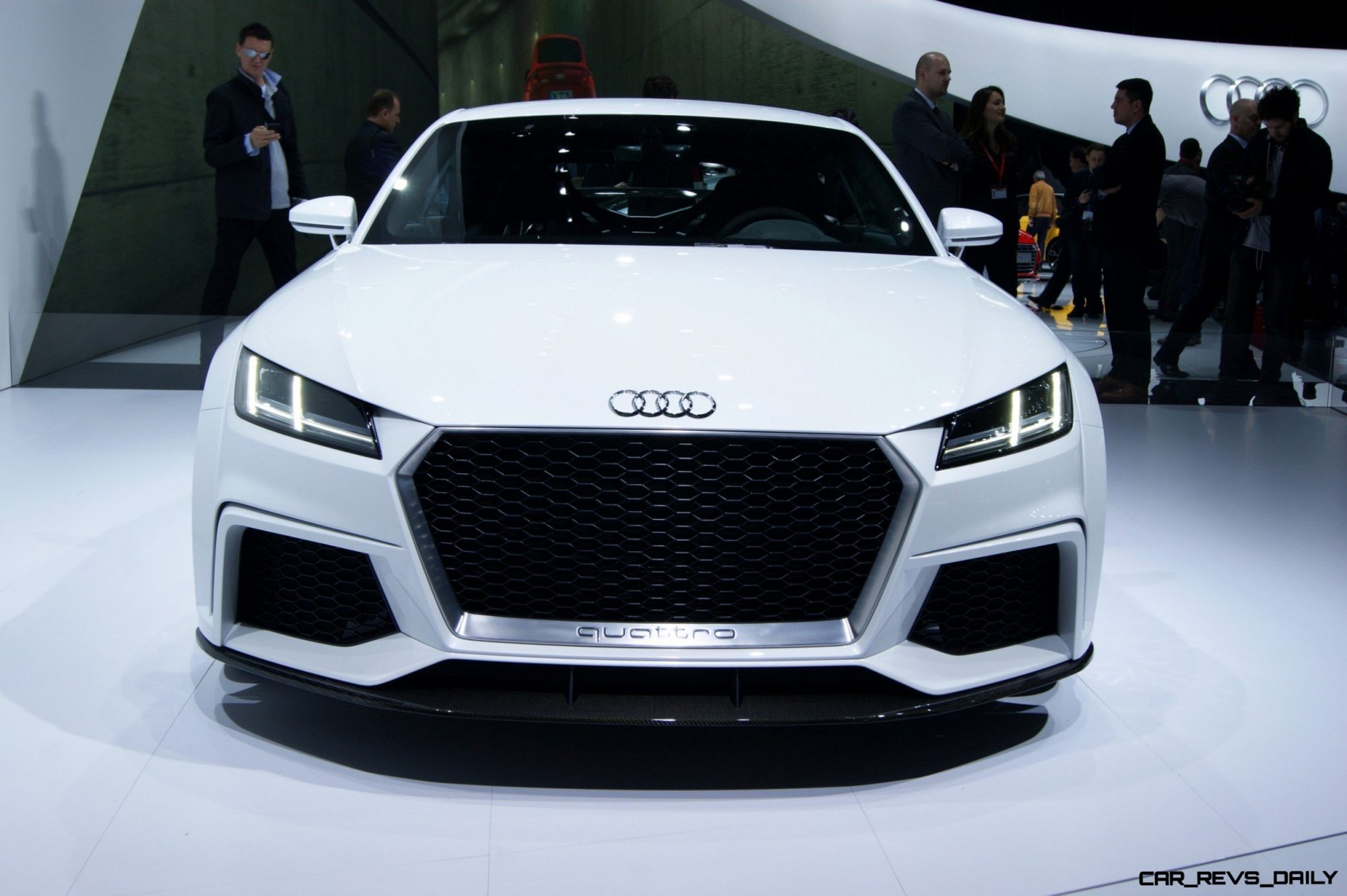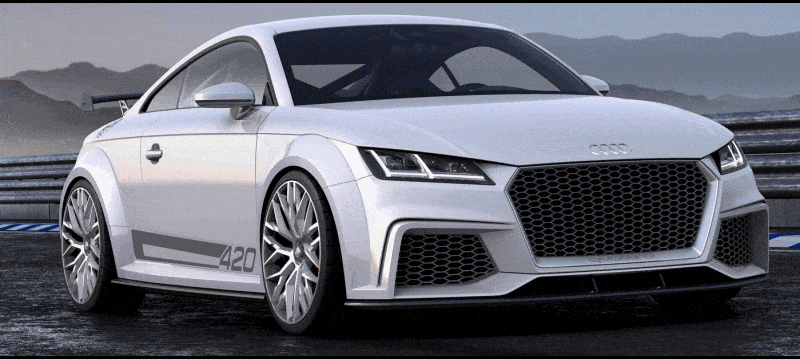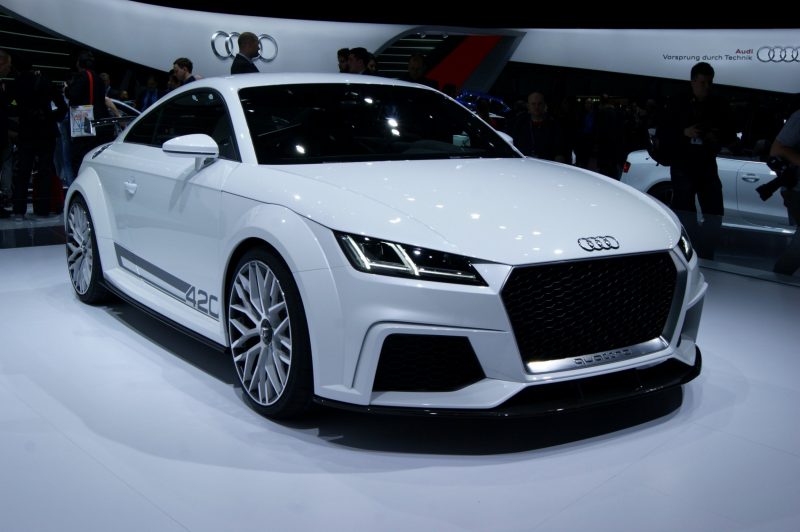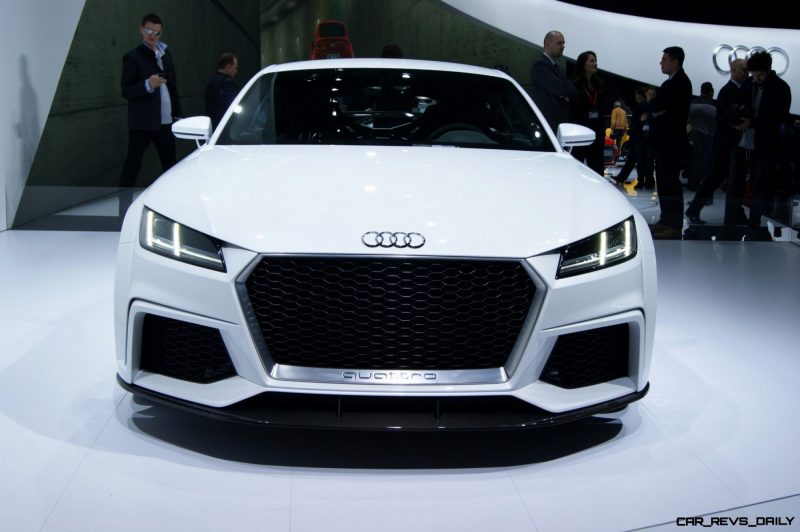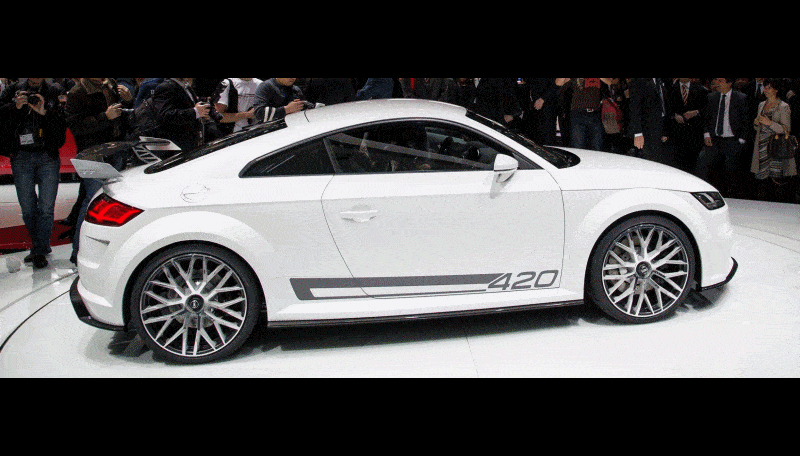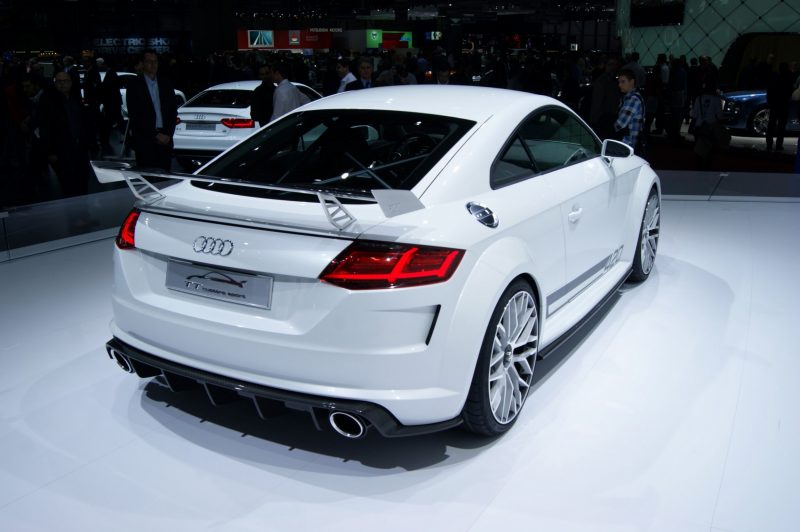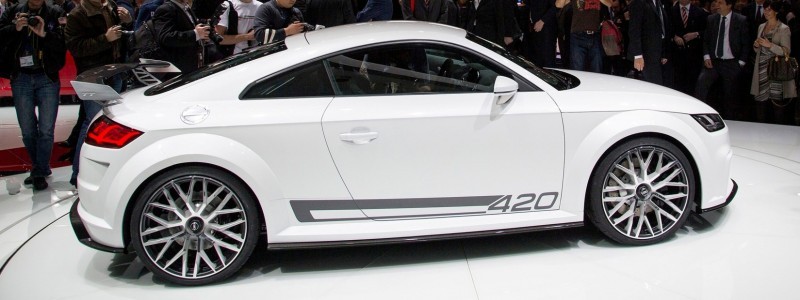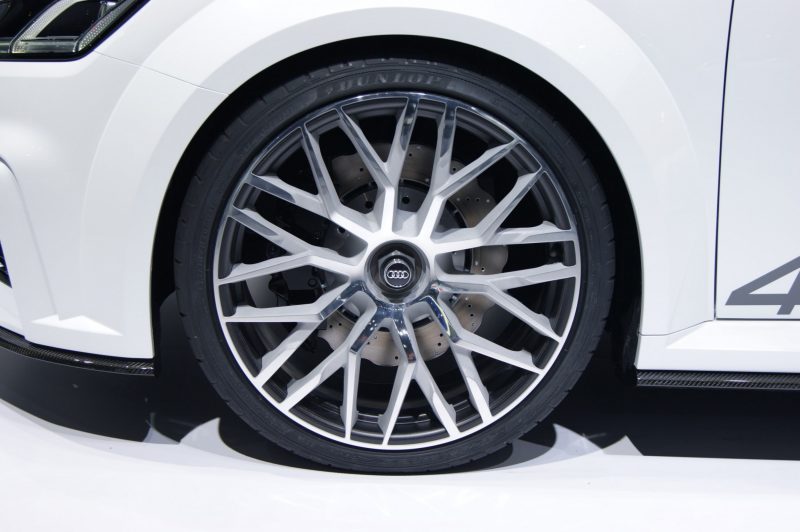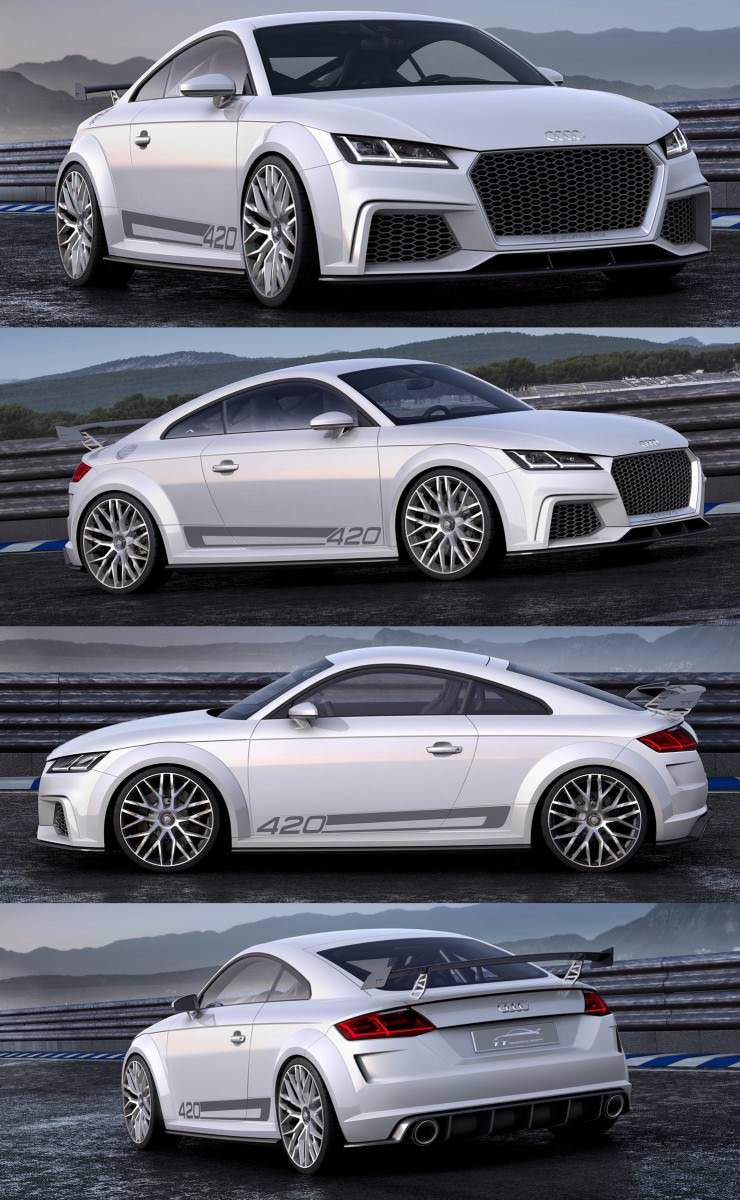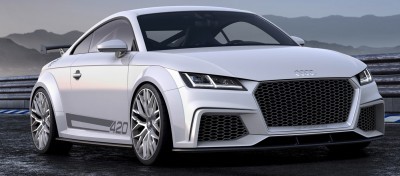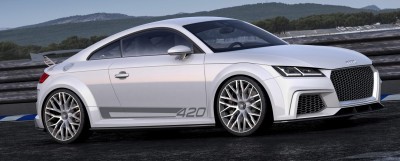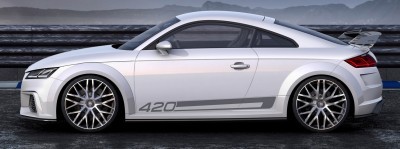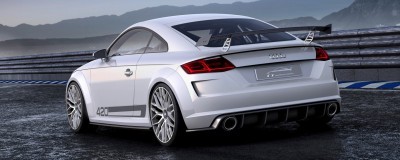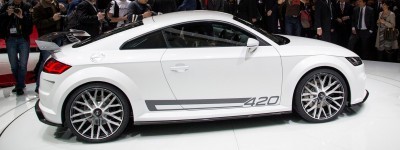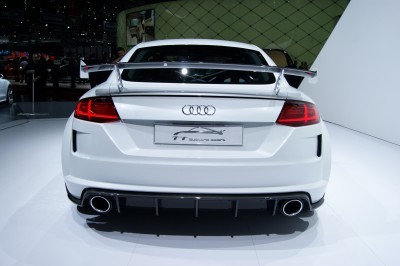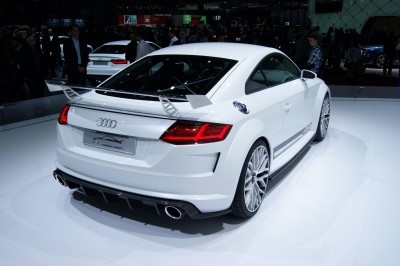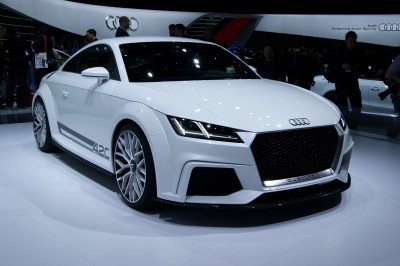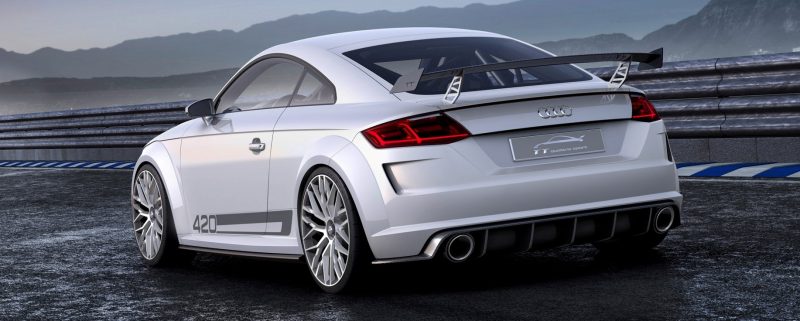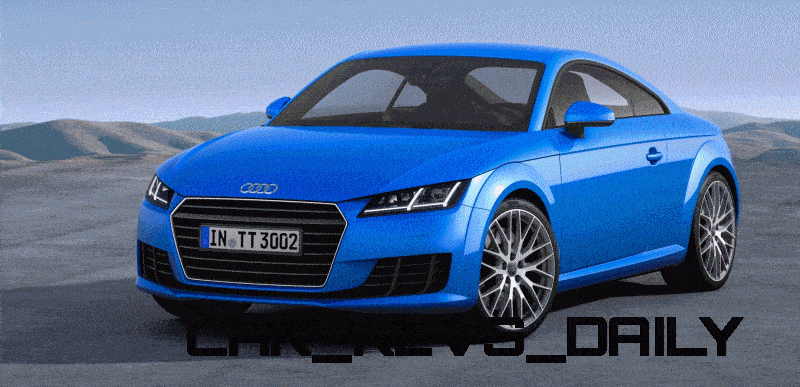The most intoxicating new TT for speed freaks?
The latest TT Quattro Sport Concept — which appears to be a possible production reality as a ‘Cup’ or ‘club racer’ model. This makes perfect sense when considered a bit more.
The chassis and price points of the base TT and the previous-gen TTRS mean it was ripe for a halo performance flagship. A car so fast and loud that it might force the world to show some respect.
If only to banish the popular TopGear critique of a hair-dresser’s car.
Sidebar: do hair stylists in the UK make more than ours do? I think a battered and clinging-to-life 2001 Kia Rio is more likely the ride of choice for most shampoo girls I know.
So how to squash all those chides like a bug? The TT SQC QSC.
Sidebar: Get it right, Tom! It is the TT Quattro Sport Concept, or QSC. I like ‘TT Cup’ best, but was not asked for my boozy-Yoda-blogger opinions on the matter. =]
This menacing concept model builds on the new TT style with a racing makeover and 420-or-so horsepower.
That is certainly nothing to sneeze at from a 2.0-liter engine — and enough for Audi below to promise a sub-4.0-second sprint time in the release below.
But best of all? This is a TT that oozes masculinity from every pore — which is critical for earning back the long-gone respect for the previous model versus the Porsche Boxster and BMW’s hot-hatch-killers: the 135i and 235i.
Handling purity of the TT SQC will be vastly enhanced, hopefully with much of this information informing the regular TT’s balance in corners as well.
But just imagine the prospect: a 3.6s Audi TT! Certainly enough to mess up your hairstyle…
Four cylinders, 420PS – the Audi TT quattro sport concept
Geneva show car based on all-new Audi TT features four-cylinder TFSI engine with exceptional 420PS output
- Four-cylinder 2.0 TFSI engine with 420PS
- Over 312PS per ton, 0-62mph in 3.7 seconds
- Prof. Dr. Ulrich Hackenberg: “An extreme driving machine for the motorsports enthusiasts among our customers”
The scope for taking the power and performance of the Audi TT Coupé to unprecedented extremes has been explored in the TT quattro sport concept, a stunning 420PS show car based on the all-new TT which made its world debut this week at the Geneva Motor Show.
“With our Audi TT quattro sport concept show car, we wanted to demonstrate what the new TT’s technology can do if you take it a step further,” explains Prof. Dr. Ulrich Hackenberg, Board Member for Technical Development. “This car is designed for racing – an extreme driving machine for the motorsports enthusiasts among our customers.”
Powertrain
The four-cylinder, 2.0-litre TFSI engine in the Audi TT quattro sport concept makes a powerful statement. Delivering 420PS at 6,700 rpm, it establishes a new benchmark in the 2.0-litre category. Its specific output is 210PS per litre of displacement – more than 2001’s victorious Le Mans R18 racing car, which combined turbocharging with FSI direct injection for the first time in an Audi petrol engine. It also makes a maximum of 450 Nm of torque (331.90 lb-ft) available from 2,400 to 6,300 rpm, and even at just 1,900rpm is still able to deliver over 300Nm (221.27 lb-ft).
Tipping the scales at a relatively featherweight 1,344 kilograms, helped by paring back interior trim and equipment, and by the production car’s advanced Audi Space Frame construction and extensive aluminium panel content, the Audi TT quattro sport concept achieves an exceptional power-to-weight ratio of 312.5PS per ton. As a result, the four-cylinder engine can catapult it from 0 to 62mph in just 3.7 seconds.
Head of Powertrain Development Dr. Stefan Knirsch: “This high-performance power unit is an impressive demonstration of the power reserves available in our EA888 engine range. This power unit has received numerous awards all over the world and it already lives up to its claim in many Audi sporty models. In the TT quattro sport concept, it demonstrates its full power potential. The thirty-five years of experience we’ve gained in the field of turbocharging are manifested in this engine’s unique combination of maximum performance, dynamism, and fuel efficiency.”
The high-performance engine benefits from the successful EA888 technologies such as the Audi valvelift system (AVS) variable valve timing, dual camshaft adjustment, and dual injection system (FSI plus MPI). A wide range of modifications are featured, including special aluminium pistons with integrated cooling channels and an ultra-high-strength forged steel crankshaft.
The cylinder head has been further developed to enable it to contend with the higher loads and increased gas throughput, and the familiar, highly compact thin-wall cylinder crankcase has been strengthened in view of the higher power output through the use of a high-strength cast alloy. The exhaust-gas turbocharger is also a new development incorporating optimized mixed-flow technology, and produces up to 1.8 bar of charge pressure.
When driving, the four-cylinder unit’s reactions are breathtaking. The turbocharged direct-injection engine responds immediately to the throttle and revs eagerly right up to the fuel cut-off at 7,200 rpm. It transfers its torque to a compact, three-shaft S tronic dual-clutch transmission which shifts gears in split-seconds, adding its share to the show car’s impressive acceleration.
The permanent quattro all-wheel drive system oversees the smooth transfer of power to the road. Its hydraulically actuated, electronically controlled multi-disk clutch is located on the rear axle for optimum weight distribution, and can actively redistribute drive torque between the axles in milliseconds
Chassis
With its cutting-edge chassis – MacPherson suspension with aluminium components at the front and a four-link layout at the rear – the Audi TT quattro sport concept offers sharp and ultra-precise handling, helped by a near-perfect 54 per cent to 46 per cent weight distribution and a stiff set-up which brings the body closer to the road than the series-production TT. ESC electronic stabilisation control helps to maintain composure in conjunction with the quattro system, but it can be partially or fully deactivated if required.
When cornering, wheel-selective torque control kicks in. If necessary, drive torque is transferred from the wheels on the inside of the bend to those on the outside. This redistribution helps to push the car very slightly into the corner, increasing the impression of sharpness and precision.
Body
A significant part in the Audi TT quattro sport concept’s lightweight design is played by the body, which is based on the MQB modular transverse matrix. Its hybrid construction represents the latest evolution of the Audi Space Frame (ASF) and further lowers the car’s centre of gravity compared with the second-generation series-production TT.
The front end is made of steel. The passenger compartment floor comprises high-strength, hot-shaped steel components which, thanks to their extremely high strength, feature very low wall thicknesses which help to reduce weight. The compartment’s structure, the entire exterior skin, and the doors and lids are made of the classic Audi semi-finished aluminium products cast node, extruded profile, and sheet metal.
Exterior design
The flat Matrix LED headlights, substantial air intakes and broad Singleframe grille with its quattro logo and dark diamond patterned centre section dominate the study’s front view. A splitter made of carbon fibre-reinforced polymer (CFRP) rounds off the front end at the bottom and increases the downforce on the front axle.
The silhouette of the Audi TT quattro sport concept – which is finished in Crystal White – is purposeful from every angle. The already pronounced TT wheel arches, which frame 20-inch wheels with a central locking mechanism and semi-slick tyres, are extended here by a further 30mm, and are connected by powerfully accentuated sill extensions. Their lower segments are made of CFRP. Together with the splitter and the rear diffuser, which stretch all the way to the wheel arches, they form an aerodynamically effective contour.
At the rear, the wide CFRP diffuser underlines the show car’s racing character. Delineated by vertical edges, it surrounds two large, fully circular tailpipes. Large air outlets are positioned on the sides beneath the taillights. A large, fixed wing increases the downforce on the rear of the Audi TT quattro sport concept.
Interior styling
The show car interior has been reduced to the essentials. Numerous components that are dispensable on the race circuit have been taken out. The door panels have been stripped of armrests and speakers, and diagonal strips of Alcantara act as door handles. Low-set racing buckets serve as seats, featuring black four-point seat belts with white accentuating stripes. The luggage compartment offers space for two racing helmets.
As in the series-production TT, the controls are designed primarily with the driver in mind. That driver has his or her hands on a compact steering wheel with a pronounced rim and a flat bottom. The steering wheel’s spokes house the red start/stop button alongside the keys and rotary buttons for operating the Audi virtual cockpit. Depending on the mode chosen, the fully digital instrument cluster’s 12.3-inch display shows different views.

Tom Burkart is the founder and managing editor of Car-Revs-Daily.com, an innovative and rapidly-expanding automotive news magazine.
He holds a Journalism JBA degree from the University of Wisconsin – Madison. Tom currently resides in Charleston, South Carolina with his two amazing dogs, Drake and Tank.
Mr. Burkart is available for all questions and concerns by email Tom(at)car-revs-daily.com.

